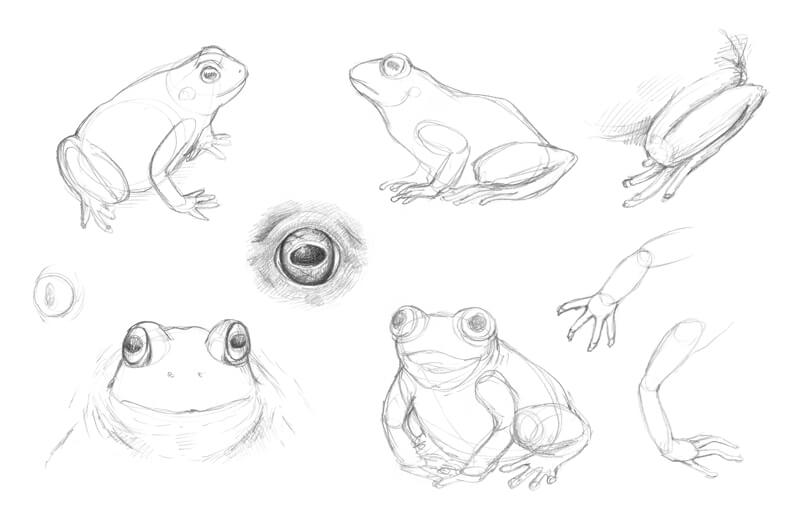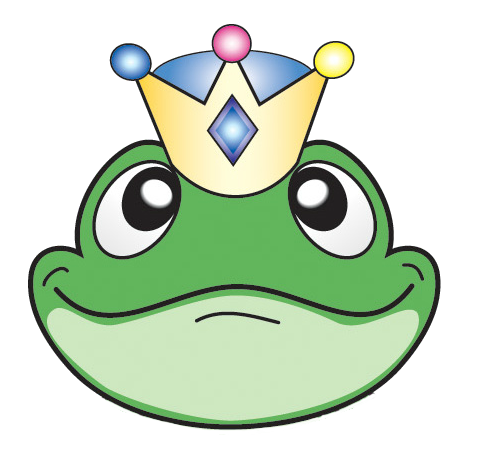


Draw some slightly curved lines on both the bottom hind leg and foreleg. Drawing webbed feet may seem intimidating, but we are starting with some construction lines to help you plan out the shape. Step 5: Drawing the Webbed Feet and HandsĪt this stage, we start to add the details that will bring our frog to life, beginning with the feet and hands. The head should be slightly smaller than the large back leg and should sit snuggly into the top of the body oval.Īt this stage, you should start to see the form of a frog peeking through your construction drawing. This will help to separate the head from the body and aid with proportioning elements of the head according to a realistic scale. In this step draw an angled oval shape at the top, within the body of the frog. The last big body part that we need to construct is the head. Ovals are the basis for all the parts of this frog, so it will come as no surprise that you need to use an oval to represent the arm, So far, all of our ovals have been facing upwards in a similar direction, but this arm is going to be angled downwards, from roughly the center of the torso.Īt this stage, your drawing should look something like this. The reason behind this is because of the angle of the frog’s body, the other arm is hidden behind the torso. While we drew two back legs, we are only going to draw a single front leg or arm.

The difference in size between the ovals is essential because it represents the depth of our three-dimensional drawing. It is important that both of these leg ovals slightly overlap with the body oval. Next, draw a much larger oval shape slightly ahead of and below the smaller oval. Start by drawing a small oval shape on the top of the large oval at the very back, like the one you can see in our example. We will begin with the back legs, because they can be the most tricky and it is always good to get the hardest things done first! The trickiness comes from ensuring that you reflect the correct proportions between your back legs, because the one is further back than the other. Now that we have the body of our frog constructed, it is time to start planning out the limbs. At this stage, your drawing may not look anything like a frog, but in just a few simple steps, you will be surprised at how quickly it takes shape! Step 2: Constructing the Back Legs Make sure that you center the oval on your piece of paper or canvas while leaving enough space on all sides for the other limbs. The size of the oval will represent the final size of your frog’s body. Begin by drawing an angled oval shape to represent the body and posture of the frog we will be drawing. The best way to begin drawing any animalwhen it is your first time is to use simple shapes. So, find your reference photo, gather up your supplies, and let us get started with drawing frogs!

We always suggest finding a reference photo of the frog you want to draw so that you can use this later in the tutorial when we begin to add details and coloring. There are so many different types of frogs to choose from when it comes to creating your own drawing.
#FROG HEAD DRAWING HOW TO#
Step-By-Step Instructions on How to Draw a Frog
#FROG HEAD DRAWING SKIN#
The beautifully varied skin of different frogs is shed completely every single week! Each frog species has its very own croak, which male frogs use to attract their mates. The collective noun for frogs is an army, and the majority of them can jump almost 20 times their own height. While in this tutorial we are focussing on one frog, there are over 4,700 species around the globe. 3.1 Can a Beginner Follow this Tutorial?.2.12 Step 12: Step Back and Admire Your Handywork.2.11 Step 11: Color Highlighting, Smearing, and Blending.2.9 Step 9: Giving Your Frog some Character.2.8 Step 8: Fine Lining and Shaping Your Frog.2.7 Step 7: Drawing the Eyes, Nostril, and Mouth.2.5 Step 5: Drawing the Webbed Feet and Hands.2.3 Step 3: Constructing the Foreleg or Arm.2 Step-By-Step Instructions on How to Draw a Frog.1 An Introduction to the World of Frogs.


 0 kommentar(er)
0 kommentar(er)
